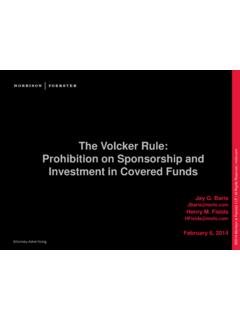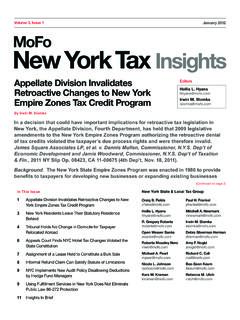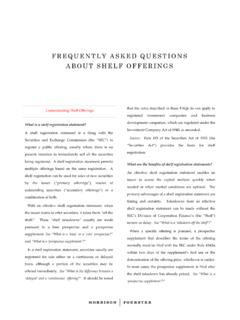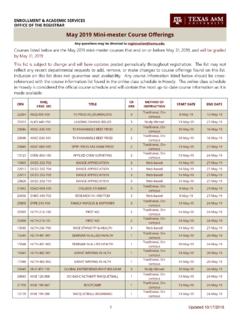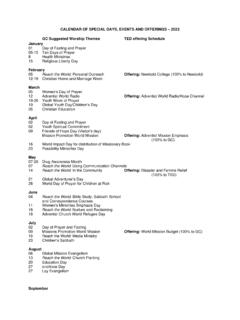Transcription of FREQUENTLY ASKED QUESTIONS ABOUT RIGHTS OFFERINGS
1 FREQUENTLY ASKED QUESTIONS ABOUT RIGHTS OFFERINGS Background What is a RIGHTS offering ? A RIGHTS offering typically provides an issuer s existing shareholders the opportunity to purchase a pro rata portion of additional shares (also referred to as subscription warrants ) of the issuer s stock at a specific price per share (the subscription price ), which is typically set at a discount to the recent trading price of the issuer s stock. How are RIGHTS distributed? All shareholders are given the right to purchase shares based on the number of shares they own on a specified record date, so there is no dilutive effect to shareholders who exercise the RIGHTS issued to them. Does a RIGHTS offering require shareholder approval?
2 Because there is no dilutive effect, stock exchange rules do not require issuers to obtain shareholder approval for issuances of 20% or more of the outstanding shares at a discount to current market value in connection with a RIGHTS offering . How long does the offering period remain open? The RIGHTS offering is typically open for a period of 16 to 30 days, usually starting from the day that the issuer s registration statement relating to the RIGHTS offering becomes effective. There are no federal securities laws requiring the RIGHTS offering to be open for a specified period of time. Can the RIGHTS be transferred? Most RIGHTS OFFERINGS involve non transferable RIGHTS . If a shareholder decides not to exercise its non transferable RIGHTS , the shareholder s ownership in the issuer will be diluted by those shareholders who exercise their RIGHTS .
3 However, an issuer may elect to structure an of fering to permit RIGHTS to be transferable. In transferable RIGHTS OFFERINGS , shareholders who choose not to exercise their transferable RIGHTS can trade them in the secondary market during the offering period. The money earned from trading the RIGHTS provides compensation to shareholders who do not wish to participate in the RIGHTS offering by enabling the shareholders to offset dilution by earning a profit trading the RIGHTS . How are transferable RIGHTS traded? Trading of the transferable RIGHTS takes place on the exchange where the issuer s common stock is listed, or over the counter if the issuer s stock is not listed on an exchange.
4 1 What is a step up privilege ? A step up privilege may be offered to shareholders when the RIGHTS are not easily divisible by the subscription ratio. In such situation, if a shareholder fully exercises the RIGHTS , the shareholder will be permitted to subscribe for one additional full share in lieu of the fractional share that would have been granted, without furnishing any additional RIGHTS . What is an over subscription privilege ? An over subscription privilege provides a shareholder who fully exercises the RIGHTS , including any step up privilege, if applicable, to subscribe for an additional number of shares, usually not more than the aggregate number of shares subscribed for pursuant to the basic RIGHTS and the step up privilege.
5 The over subscription privilege is subject to allotment, and shares will be distributed on a pro rata basis if allotment does not exist to fulfill all requests. How are shares obtained through an over subscription privilege distributed? The pro rata distribution can be handled in one of the following two ways: (1) as nearly as practicable in proportion to the shares requested; or (2) as a ratio, in that the RIGHTS exercised by each shareholder exercising the over subscription privilege bears to the total number of RIGHTS exercised by all shareholders exercising the over subscription privilege. Types of RIGHTS OFFERINGS What is a direct RIGHTS offering ? In a direct RIGHTS offering , there is no backstop commitment party, or standby purchaser.
6 Instead, the issuer only sells the number of shares evidenced by the exercised RIGHTS . A direct RIGHTS offering is cheaper than an insured RIGHTS offering (or standby RIGHTS offering ) because there are no fees associated with providing the backstop commitment. However, a poorly subscribed direct RIGHTS offering may leave an issuer under capitalized. What types of issuers would benefit most from a direct RIGHTS offering ? Large, well capitalized issuers who are looking to raise capital but do not have a specific capital raising goal or who are established enough to expect many shareholders to exercise their RIGHTS may benefit from a direct RIGHTS offering . Also, issuers that have identified interest from an existing shareholder, or shareholders, may benefit from a direct RIGHTS offering .
7 What is an insured RIGHTS offering ? In an insured RIGHTS offering (also referred to as a standby RIGHTS offering ), a third party (usually an underwriting syndicate, an investment bank, an affiliate of the investment bank or an affiliate of the issuer) agrees, prior to the commencement of the RIGHTS offering , to purchase any shares or RIGHTS that are not exercised in the RIGHTS offering . This arrangement is commonly known as a backstop commitment or a standby commitment, and provides the issuer with a guarantee that it will raise the necessary capital. If the RIGHTS offering is structured as a standby RIGHTS offering , 2the issuer will enter into an agreement with the party agreeing to provide the backstop, or standby, commitment.
8 When should an issuer consider a standby RIGHTS offering ? An issuer should consider structuring a RIGHTS offering as a standby offering if the issuer must raise a specific amount of capital. By entering into an agreement with a standby purchaser, the issuer can ensure that it raises the necessary amount of capital even if all shareholders do not subscribe for their full allotments of shares. If an issuer does use a standby purchase agreement, the issuer should factor fees into the amount of the offering to make sure enough shares are offered to meet its capital needs. An issuer also may consider a standby RIGHTS offering if the issuer s stock price is volatile. This is because the offering period is usually at least 16 days but can extend up to 30 or 45 days.
9 Most shareholders will wait until the end of the subscription period to decide whether to exercise their RIGHTS . If the shares are trading in the market for the same or less than the subscription price, then shareholders will not exercise their RIGHTS . The issuer has to consider where to set it s subscription price to avoid this, while not selling the shares at too steep of a discount price. Entering into a backstop commitment can mitigate this issue. What fees are associated with a backstop commitment? As compensation for shifting the risk from the issuer if there is an under subscription, the backstop commitment party is paid a flat standby fee, plus a per share amount for each unsubscribed share purchased by it after the subscription offer expires and for each share purchased by it on the exercise of RIGHTS purchased in the secondary market, if the RIGHTS are transferable.
10 In the event that a RIGHTS offering is under subscribed and the subscription price is below the market price, the backstop commitment party usually agrees that any profits it makes from the backstop commitment will be split with the issuer. Are there any requirements to be a backstop commitment party? There is no broker dealer licensing requirement for backstop commitment parties, although most are investment banks or an underwriting syndicate formed by an investment bank. However, one or more substantial investors will sometimes agree to act as a backstop commitment party. Without a broker dealer license, substantial investors cannot engage in activities to mi tigate the risk of an under subscription.

